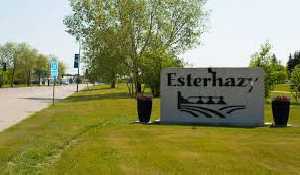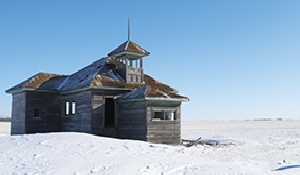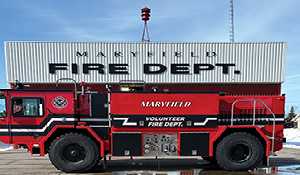Hydrology expert says future flooding may be alleviated
August 12, 2014, 3:04 am
Julia Dima

The flooding that hit Southeast Saskatchewan and Southwest Manitoba at the end of June was unprecedented. With little warning to prepare mitigation and no notion that the downpour would spill 200 mm of rain over the region over a weekend, many communities were devastated by the flooding.
The flood was unique in many ways, and Canada’s research chair in water resources and climate change at the University of Saskatchewan, Dr. John Pomeroy, says that there has never been a recorded flood like this in the region. A lot of factors went into this event.
“There has been flooding caused by rain in the province before, and it’s usually caused by convective storms—the classic prairie thunderstorm. There have been some spectacular storms, like one in Vanguard in 2000 that had over 450 mm of rain in it. What was different about this storm is that it wasn’t a convective storm, it was a large frontal precipitation event. That front was preceded by a previous front and followed by others, so the rain just kept coming,” he explains.
“Normally, Saskatchewan soils have tremendous water holding capacities and by mid-summer, they are already getting kind of dry, and they can take a lot of rain. But in this case, we had a late and cold spring, and fairly good snow melt, so the soil had pretty good moisture status. Then these rains overwhelmed the soil’s water holding capacity.”
Another important factor in why the flooding was so intense was the pressure on wetlands.
“They were starting to fill up from the large snowmelt in the spring, and the previous rains. So, they could not hold back much more water,” Pomeroy says.
“Also, the other thing we think contributed to this is because many of the ponds were drained, this reduced the water holding capacity over a large area. so, the water then flowed right onto the streams and ended up in the Assiniboine River.”
“The rain was large, and would have caused some sort of flood no matter what,” Pomeroy said.
“The fact that the rain developed at all is itself strange and unprecedented, so that’s one thing, but the second is that many producers in eastern Saskatchewan, party because of wet conditions, party because of high crop prices—all kinds of factors—have been draining wetlands at a fairly high rate—this has been going back 50 years to some degree, but especially so in recent years. And that probably increased the size of the flood.”
Pomeroy has been conducting research at Smith Creek near Langenburg for many years, analyzing hydrology changes that factor into flooding trends.
“At Smith Creek, we see a number of things. We looked at the climate over time and the duration of rainfall has changed quite a bit—the multiple day rainfall events that would create this sort of flooding have gone up by 50 per cent since the 40s and the fraction of rainfall in March has changed as well. Before 1970, only four per cent of precipitation in March was rain, and now it is 20 per cent. The air temperature has gone up quite a bit too—in March, it’s gone up four degrees since the 40s and overall it’s up a degree and a half, so there are signs of climate change there.”
Other trends have indicated a change in stream flow.
“One trend is that runoff has increased fourfold since 1994—which is a dramatic change in its behavior. The second trend is the proportion of rain-caused runoff compared to snowmelt runoff. The runoff involving rain by itself or coupled with snow melt has gone up dramatically. Up until 1993, about seven per cent of the stream flow was caused by rainfall, and another seven per cent was mixed snow and rain. Since 1994, 24 per cent is caused by rainfall, and 8 per cent is mixed snow and rain, so this has roughly doubled . . . The total amount of precipitation has not changed over time so it’s interesting that the stream flow has quadrupled without an increase in precipitation. This tells us that the hydrology has changed. Part of it is that when rains come in the summer, they have a longer duration, but that couldn’t account for it by itself. The wetland drainage is the other part of this,” Pomeroy says.
His research has shown that wetland drainage in the Smith Creek basin does have a substantial impact on flooding.
“Smith Creek has undergone tremendous wetland drainage since the 50s. In 1958, a quarter of the watershed was wetland, and now it’s down to 10 per cent. So, what we did is we took a look at some of the previous floods, like 2011, and we wanted to see this would look like if we restored the basin to what it was in 1958, and also took it further and see what it would look like if we drained all the wetlands in the basin. If we restored it to 1958 for the 2011 flood, that would cause the peak flow and volume of water to drop by one third. If we take the same flood and kept draining the basin until all the wetlands were gone, that would have increased the peak flow by 78 per cent. The total volume by 32 per cent—it has a tremendously strong impact.”
Though research at this level has only been conducted at Smith Creek, Pomeroy says the results reflect province-wide numbers from Ducks Unlimited, reporting that 70 per cent of wetlands have been drained across the Prairies since settlement.
“The numbers at Smith Creek are right in line with that, but we haven’t personally been able to do this study elsewhere yet. But our expectation is that the Prairie pothole region across the Prairies is similar.”
Pomeroy says he believes this flood and the changes in the Smith Creek basin are clear indicators that this is climate change in action. That does not mean that massive floods at this scale will become normal, but that major fluctuations in weather patterns can be expected—and are already being seen.
“What we will see is continuous change, which will be very difficult to adapt to and manage. Yes, right now we are seeing flooding, but I fully expect us to see drought as well with floods in between. This has already happened in California, and Colorado. It is happening across Canada—The Northwest Territories are in a drought that is causing widespread forest fires. The Peace River region is experiencing drought as well. So when you look at the Prairies as a whole, the northwest having drought, the east and south are having some of the wettest summers on record, and this is happening at the same time,” he says.
A number of factors can go into mitigating severe flooding across the Prairies, but Pomeroy says the primary solution is to restore wetlands across the region.
“The details of which ones to restore is a more difficult problem because the Canadian Prairie landscape is quite unique in the world. We were very heavily glaciated, and our soils were all deposited by the glaciers, and underneath them is the heavy clay glacial till. When we have a hill or valley or slough, it was put there by ice, not water, as is the case elsewhere. So, the techniques developed in Western Europe or Eastern Canada just don’t work in our landscape.”
However, Northern parts of the United States do resemble the same topography as the Canadian Prairies, and communication with the United States Department of Agriculture indicates wetland restoration is the solution.
“They are recommending wetland restoration, and they are saying that there are too many that have been drained, and they need to be restored—most answers point in that direction.”
However, restoration of wetlands on the Prairies causes tension with the agricultural sector, because maintaining sloughs and wetlands reduces acreage.
“Talking to farmers right now, the tax regime encourages draining wetlands so there is greater cultivated acreage. The price of crops is high so there is great incentive to do this, and they are in a situation of having many wet years in a row, and they are getting frustrated, so they are trying to get water off their land,” Pomeroy says. “So, some of these things, you can probably put an economic incentive in there to say, hey, if you preserve your wetland, we’ll compensate you for it, because you’re providing a service for the people downstream. If they are providing a service by holding back floodwaters, why wouldn’t they be compensated?”
Pomeroy says that one concern farmers may raise is that increases in wetlands can result in an increase of precipitation.
“Wetlands do evaporate more than dry lands and this puts more water vapor into the atmosphere in dry periods when soil moisture is low and crops have stopped growing,” he says. “And there is a feedback between evaporation and convective storms. But no-one has linked wetlands to precipitation levels.”
Pomeroy says agricultural engineering can play a big part in mitigating flooding downstream, and damage to crops.
“One option is drains with gates that could be opened to release water after the floods are finished, and allow farmers to cultivate, and can be closed when major floods are coming. I think that would show some potential. The other thing would be saying, ‘well, we’ve drained a lot of wetlands, do we need to restore all of them?’ Perhaps not, perhaps it’s just the big ones and the ones in the lower part of the watershed that are the most important. So, we have to look at where they are in the landscape and how important they are hydrologically before we talk about which ones to restore . . . In the past, we had Prairie Farm Rehabilitation Administration to help farmers with design of ponds and dugouts, which hold back water. There’s still a need for an agency like that to provide engineering advice and guidelines for farmers, I think. So, these are all things that can be pursued.”
Pomeroy says there is a lot that provincial and federal governments can take initiatives to make these flood mitigation solutions possible.
“There are a number of things our governments can do. One is that the regulation of water drainage comes from the Water Security Agency of Saskatchewan. And they are still considering wetland restoration as a policy alternative—but they might want to speed that up a little bit. When they are still sitting on the fence on whether wetland drainage has any impact, that puts them in a situation where they’re saying something is not certain when in fact it is applied all over the world. So it probably should be part of Saskatchewan’s arsenal as well in fighting these floods—there is a cost, and it’s difficult to implement, but Manitoba has already moved forward and said wetland drainage is now illegal. That’s an easy step to start with,” Pomeroy says. “It’s also a matter of changing the tax regime, so there is no tax incentive for farmers to drain a wetland, and that can be done very simply. There have been different incentive programs over the years for other things, so there is lots of expertise on how to do this.”
Another big challenge in the prediction and mitigation of floods is a miscommunication in the forecasting system, Pomeroy says.
“The floods and droughts don’t respect provincial or national boundaries . . . This year, the rains occurred in Saskatchewan, but water carried to Manitoba. So, it makes sense for the provinces to work together on flood forecasting, and what they’ve all experienced is that they are overwhelmed by the nature of these events alone,” he says. “However, rainfall forecasting is done by the federal government, but the flood forecasting is done by provincial governments, and that is frankly strange. In other countries, the rainfall and flood forecasting are all done by one unit. These should not be done in different groups. You need to have people in the same room. It’s inefficient and ineffective, we had very little warning of these floods when they came. With a few more days, or a week of warning, people could have had better preparation.”
All of these solutions taken into account would never completely prevent a flooding event of this scale from happening, according to Pomeroy. However, the floods would be smaller.
“The flood this summer was pretty big, and we might have taken one third off of that with wetland restoration—which would still help.”



































